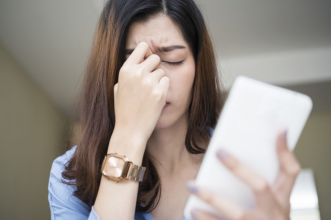At a time when the use of technology is on the rise, ignoring its impact on our health is not an option. The use of smartphones has penetrated almost every corner of the globe and blue light exposure is now at an all-time high.
Using your smartphone for too long gives you long hour’s exposure to blue light which isn’t friendly to your eyes.
What is blue light?
It’s a colour in the visible light spectrum with a short wavelength that produces higher amounts of energy which are harmful to the eye. Its major source is the sun. However, in this digital era, these harmful rays are also produced by digital devices such as TVs, smartphones, computers, laptops, etc.
If blue light is produced by the sun and other devices, why does the use of smartphones pose a greater risk to your eyes? Well, its simple, smartphones are mobile devices and since they are used very close to the eyes, the blue light impact is greatly magnified.
How using a smartphone will ruin your eyes
Age-related Macular degeneration
This is a condition that majorly affects the central part of the retina and results in loss of central vision. It is the leading cause of blindness, and it mostly affects people above the age of 60. As screen usage increases, there’s a corresponding increase in the exposure to the blue rays hence accelerated age-related macular degeneration. The retina, being a very thin multi-layered tissue, can easily be harmed by high energy visible blue light that penetrates the macular pigment in the eye. Blue light destroys the photoreceptor cells hence hindering central vision and since it’s beamed directly into the retina, it causes more damage than other forms of light.
Computer vision syndrome
It is also referred to as digital eye strain. This describes a combination of eye and vision related problems that result from prolonged usage of technological devices such as cell phones and computers. It’s mostly experienced when one is using digital devices for long periods. As the use of digital devices becomes more rampant in our daily lives, the number of digital eye strain cases also increases. The symptoms of this condition are eye strain, blurred or double vision, physical and mental tiredness, red or irritated eyes, headaches, dry or watery eyes, difficulty focusing, sensitivity to light among others.
These symptoms can be noticed even after someone has used a digital device for as little as 2 hours a day. Studies show that 60% of individuals spend about 6 hours or more a day in front of a digital device. 70% of them report some symptoms of computer vision syndrome which include: Neck, shoulder, or back pain.This condition also impacts your ability to focus and brings down productivity. Most people do nothing to ease their discomfort from these symptoms because they are not aware of the cause.
How Do You Protect Yourself from the Dangers of Smartphones?
You can take a number of steps to reduce the occurrence of computer vision syndrome and macular degeneration:
Taking Regular Breaks
Staring at your smartphone for long periods of time exposes you to incredible amounts of blue light and strains your eyes and neck muscles. Take breaks from your smartphone by engaging in other activities such as reading a book, going for a walk, or hanging out with friends. Furthermore, discipline yourself to avoid using your smartphone while doing other activities.
Limiting Screen Time
You can deliberately set times for when to use your phone and when not to. You can set an alarm to alert you when to put your phone down. This should be done especially at night when blue light is most harmful. The temptation to use it may be irresistible so you turn off social media notifications to avoid losing your eye on the goal. Limiting screen time is also important for children who don’t understand the dangers of blue light.
Using Eye Drops
Eye drops to relieve you of eye strain are readily available in your local pharmacy. They hydrate your eyes and keep them from drying out too quickly since the blinking rate goes down when you look at a screen.
Holding Your Smartphone Properly
As you text or browse, hold your smartphone at eye level to avoid straining your neck muscles. Remember to also hold it at an arm’s length to prevent overexposure to blue light.
Adjustment of lighting
When there’s a big contrast between your device’s brightness and the surrounding light, it strains your eyes. Adjusting your smartphone’s brightness to match the surrounding will go a long way to reduce the symptoms of computer vision syndrome.
Screen Protectors
Considering the negative impacts, should we forget about using our screens? Definitely not! Ocushield offers you medically proven blue light blocking glasses that help minimizing the impact of the exposure to blue light. They are made with special coatings that either block partial or all blue light coming from your device. Depending on your preferences, you can request a blue light filter test from your retailer to determine which product is best for you.
The smartphone and computer screen protector also gives you a crystal clear display since it doesn’t have the retro orange tinge. It also protects your screen from accidental falls and scratches with a super-strong tempered glass. The Ocushield screen protector comes with an applicator that helps you eliminate the bubbles that are synonymous with screen protectors. An anti-glare coating on the screen protector is an added feature to save you from the strain that is caused by light bouncing off the screen and onto your eyes.
A screen protector will ensure you use your smartphone optimally while at the same time filtering out blue light and guaranteeing the health of your eyes.
This is an article provided by our partners network. It does not reflect the views or opinions of our editorial team and management.
Sponsored content

Founder Dinis Guarda
IntelligentHQ Your New Business Network.
IntelligentHQ is a Business network and an expert source for finance, capital markets and intelligence for thousands of global business professionals, startups, and companies.
We exist at the point of intersection between technology, social media, finance and innovation.
IntelligentHQ leverages innovation and scale of social digital technology, analytics, news, and distribution to create an unparalleled, full digital medium and social business networks spectrum.
IntelligentHQ is working hard, to become a trusted, and indispensable source of business news and analytics, within financial services and its associated supply chains and ecosystems





























